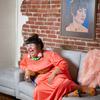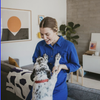Swap It, Mend It, Make It Work: Anti-Capitalist Practices in Plus-Size Fashion.
May 4, 2021 — Articles
Written by
 Virgie Tovar
Virgie TovarIllustrations by
 Jordan
Jordan
During the summer of fifth grade, my grandma and mom (both plus-size women) decided that their sewing project for the season would be making the three of us matching outfits using cheetah print denim they’d found at the fabric store.
My mom - a young, bubbly and still-very-much-wanting-to-date single parent - designed a skin-tight mini-skirt with the fabric.
My grandmother - a slightly more reserved, but still very hot lady - opted into a longer, less fitted version.
And for me, they made a ruffled jumpsuit.
I still remember the photo shoot they put together, the three of us looking like a display of melanated Russian nesting dolls: my mother was the tallest, grandma was a little shorter, and me - the smallest: pudgy and grinning.
We were all larger than the size runs available to us at the mall. And the things that did fit weren’t really “our style” (i.e., they really just weren’t fabulous enough). Like a lot of plus-size women, my mom and granny sewed because it was a thrifty way to meet their needs. But they always made it fun. They wouldn’t have exactly called what they were doing “anti-capitalist,” but to me (a socialist-leaning feminist) I don’t know what else you would call this ongoing DIY collaboration that rejected what the market had to offer and put manufacturing squarely in their own hands.
The characteristics of U.S. capitalism include competition, private ownership, homogeneity, and rapid turnover - often at the expense of people and the environment. What I’ve seen emerge in certain corners of the plus-size fashion world is an alternative model, which centers solidarity, personality, resource sharing, creative reuse and mutual assistance.
Up against fashion industry discrimination, social stigma, as well as the income gap between plus- and straight-size women (estimated to be $9000 annually, with plus size women frequently being shunted into more physical and lower-paying jobs), plus-size women swap, sew, teach each other patterning, and provide each other the love we don’t get from brands.
Cat Polivoda, owner of CAKE Plus-Size Resale in Minneapolis, says that the idea for her store began with an experience she had in 2014. With some clothes to sell, she decided to turn to her plus-size community online first and was able to make $300 in a weekend. This small decision showed an innovative willingness to flex her power: prioritizing selling to plus-size people she knew, and refusing the option of going through a middleman who may or may not be invested in her community. She says that the selling experience helped her connect with people, and that their conversations quickly turned to body positivity and fat liberation. In my experience, plus-size shopping lends itself to political conversations, and it’s not uncommon to see spaces specifically created for that inside shops catering to plus-size customers.
Back when plus-size resaler, ReDress, had a brick-and-mortar location in Brooklyn there was a community lounge area that had fat-positive zines to read and images of body positive activists to admire. Mixing community-building with business is a practice that shares history with many alternative economies, like Black Wall Street. In the 1920s, for instance, a plus-size woman named Bessie Whitted would lead her fellow workers at the North Carolina Mutual Life Company in songs that commemorated well-respected members of the Black business community - on company time.
The community lounge at ReDress was an area designed to build community, to educate, to politicize and - significantly - to rest. Angela Trakas, founder of the Fierce Fat Babe Collective, says, “The elements of rest, community and solidarity are where the anti-capitalist spirit really lives.”
Angela points out, “Some of the ways that you can be anti-capitalist are limited for the plus-size shopper if you’re on the bigger size of the plus spectrum.” As a size 4X/5X, she says going to thrift stores is often disappointing because the pipeline of stylish, interesting clothes beyond 2X or 3X just isn’t there. In her former career as a jewelry maker, she made use of thrifting in a different way, however. Her business was centered on offering alternatives to the subtle, smaller jewelry trending in the market. She upcycled things she’d found at thrift stores to make bold pieces that served bodies like hers: longer necklaces and girthy earrings that don’t get lost on a large frame.
I see this kind of ingenuity in another plus-size mainstay: clothing swaps. I remember my amazement at the first swaps I attended in 2011 and 2012. Plus-size women opened up their private homes for these events. Living rooms became alternatives to the boutiques where fatphobic comments and limited sizing always lurked. Kitchens and bedrooms were transformed into colorful bazaars. The message of abundance - not scarcity - lived in the piles and piles of clothes spilled all over sofas, chairs, beds, and floors. Compliments were shared easily and generously. We were frequently reminded that there was enough for everyone, creating an opportunity to engage with clothes in a non-competitive way.
Unlike the Big Box urge to create a one-size-fits-all experience, each swap had different rules. At one swap we were asked to take into account our privilege as we chose which items to take, and to leave items in hard-to-find sizes unless we really planned to wear them often. During another, we were instructed that if we were swapping a particularly meaningful item of clothing, we could leave a note on the garment that told its history and importance so it would go to the right new owner. We celebrated each other, met new friends, commiserated about our fashion problems, and shared updates about our lives.
Plus-size fashionista Sarah-Anne of Tonsa Blush says, “These swaps are important to try to... reduce isolation for people that are often overlooked by the fashion industry and even in society in general.” To the plus-size community, conversations about fashion are conversations about mental health and access. For instance, the volunteers of the Oakland-based plus-size swap/sale, Cupcakes & Muffintops, construct extra large dressing rooms designed to accommodate people with disabilities and attendees’ big bodies.
Resource-sharing doesn’t stop at swapping. I recently asked plus-size women on Instagram what fashion skills and advice they’d learned from other plus-size people. “How to sew my own clothes that make me happy,” said one. “Buy that weird length vintage skirt or dress at the thrift store and hem it. It makes a world of difference,” said another. Some had been taught how to draft up straight-size patterns, revamp old or small clothes, and mend rather than replace. Though many spoke of these skills and practices as empowering, it’s important to note that anti-capitalist methods can also be emotionally taxing when there's no alternative. “Making clothes, swapping and thrifting is sometimes frustrating rather than joyful,” said one respondent. “It feels exhausting to be plus-size and anti-capitalist,” shared another.
I spoke with Melissa Gruver, a Fat Organizer in Lafayette, Indiana about what anti-capitalism looks like in her life. “All the women in my family sew,” said Mel, “So I was primed to start making my own clothes - and altering thrifted clothes - at a really young age. In fact many years ago my grandmother made her living by sewing custom clothing for women who were not able to get clothing in their size at the brick and mortar stores. This was way before the internet. So I guess you could say that fat phobia pushed me closer to the means of production and there, at the sewing machine, is where I started my journey towards anti-capitalism. Capitalism controls whole communities of people by controlling our bodies: where we go, what we wear, how much it can exploit us & our labor. One of my favorite things I’ve done in fat community as a resistance to this was a couple of years ago. We brought a bunch of fabric scraps, a couple of sewing machines & thrifted tees to our local bar, the Spot Tavern, and created what we called a Crop Top Pop Up Shop. We were cutting and sewing and trying on these clothes and laughing and taking up so much space-reclaiming how we use our time and labor by creating community, instead of capital.
And this brings us back to the fact that plus-size women face real, life-altering discrimination. We can’t celebrate plus-size anti-capitalism without name-checking the urgent need to end the fat-shaming and restrictive sizing that have rendered these practices a need, not a choice.
As plus-size offerings continue to proliferate, the 68% of U.S. women who are a size 14 and above will have more freedom to maneuver and choose fashion practices that work for them. Though many of the practices outlined above were borne out of necessity - and frankly, bigotry - they hold tremendous value for the plus-size fashion community and way beyond it. The traditions the plus-size community has built are lessons in sustainable, community-driven, and subversive economic practice. I’m excited to see how these traditions will morph as plus-size women move out of precarity.
I return to my grandma and mom. Though I definitely don’t have the skills to recreate that 90s cheetah print capsule collection they put together on a dime, I have retained the spirit of what those pieces represented: resilience, partnership and just the right amount of attitude to ruffle some feathers (or, in this case, fur).
 Virgie Tovar
Virgie TovarVirgie Tovar is the author of You Have the Right to Remain Fat and The Self-Love Revolution: Radical Body Positivity for Girls of Color. She is a contributor for Forbes.com, where she covers the plus-size market and how to end weight-based discrimination at work. Her podcast, Rebel Eaters Club (produced by Transmitter Media), investigates the North American relationship to food and body. She lives in San Francisco with her cactus, Lumpy, and her boyfriend, Andrew.
 Jordan
JordanJordan Barton is an illustrator based out of the very hot Phoenix, Arizona. Her work is centered around deep and dreamy colors, exaggerated proportions, and turning feelings into shapes. She aims to give every person something to relate to and believes in a lighthearted approach to design. When she's not drawing, she can be found listening to true crime podcasts, playing with her dog Danger, and drinking coffee all day long.